Material used for damp proofing
1. Property of the material
An effective damp proofing material should have the following properties
1. It should be impervious.
2. It should be strong and durable and should be capable of withstanding both dead as well as live loads without damage.
3. It should be dimensionally stable
4. It should be free from deliquescent salts like sulphates chlorides and nitrates
5. The material should be reasonably cheap.
6. The material should be such that it is possible to carry out leak proof joining work.
2. Classification of material
The materials commonly used to check dampness can be divided into the following four categories
a) Flexible material
Material like bitumen felts (which may be Hessian based or fibre/glass fibre based), plastic sheeting (polythene sheet) etc
b) Semi rigid materials
Materials like mastic asphalts or combination of materials or layers.
c) Rigid materials
Materials like first class bricks, stones, slates, cement concrete etc
d) Grout materials
3. Material used for damp proofing
Following are the materials, which are commonly used for damp proofing.
1. Hot bitumen
This is a flexible material and is placed on the bedding of concrete or mortar. This material should be applied with a minimum thickness of 3 mm.
2. Mastic asphalt
This is a semi rigid material and it forms an excellent impervious layer for damp proofing. The good asphalt is very durable and completely impervious material. It can withstand only very slight distortion. It is liable to squeeze out in very hot climates or under very heavy pressure. It should be laid by experienced men of the specially firms.
Mastic asphalt
3. Bituminous felts
This is a flexible material. It is easy to lay and is available in rolls of normal wall width. It is laid on a layer of cement mortar. An overlap of 100 mm is provided at the joints and full overlap is provided at all corners. The laps may be sealed with bituminous if necessary. The bitumen felt can accommodate slight movement. But it is liable to squeeze out under heavy pressure and it offers little resistance to sliding. The material is available in rolls and it should be carefully unrolled, especially in cold weather.
4. Metal sheets
The sheets of lead, copper and aluminium can be used as the membranes of damp proofing.
The lead is a flexible material. The thickness of lead sheets should be such that its weight is not less than 200 N/m2. The lead can be dressed to complex shapes without fracture and it possesses high resistance to sliding action. It is impervious to moisture and it does not squeeze out under ordinary pressure. It resists ordinary corrosion. The surfaces of lead coming in contact with lime and cement are likely to be corroded and hence a coating of bitumen paint of high consistency should protect the metal.
The copper is flexible material. It possesses higher tensile strength than that of lead. It is impervious to atmosphere and it does not squeeze out under ordinary pressure. It possesses high resistance to sliding action. The external wall, especially of stones, is likely to be stained when a damp proof course of copper is adopted. The surfaces of copper coming in contact with mortars are likely to be affected. But for normal use, the metal does not require any protective coating.
The aluminium sheets can also be used for damp proofing. But they should be protected with a layer of bitumen.
Metal sheet
5. Combination of sheets and felts
A lead foil is sandwiched between asphalt and bituminous felt. This is known as the lead core and it is found to be economical, durable and efficient.
6. Stone
The two courses of sound and dense stones such as granite, slates etc laid in cement mortar with vertical breaking joint can work as an effective damp proofing course. The stones should extend for full width a damp proofing course. The s stones should extend for full width of wall. Something the stones can be fixed, as in case of roof surfaces, on the exposed face of wall etc.
6. Bricks
The dense bricks, absorbing water less than 4.5% of their weight, can be used for damp proofing at place where the damp is not excessive. The joints are kept open. Such bricks are widely used when damp proofing course is to inserted in an existing wall.
7. Mortar
The mortar to be used for bedding layers can be prepare by mixing 1 part of cement and 3 part of sand by volume. A small quantity of lime is added to increase the workability. For plastering work, the water proof mortar can be prepared. It is prepare by mixing 1 part of cement and 2 part of sand and pulverized alum at rate of 120 N/m3 of sand. In water to be used, .75 N of soft soap is dissolved per litre of water and soap water is added to dry mixed. The mortar thus prepared is used to plaster the surfaces. Alternatively some patented water proofing material such as pudlo, cido, dempro etc may be added to cement mortar.
9. Cement concrete
A cement concrete layer in proportional 1:2:4 is generally provided at the plinth level to work as a damp proofing course. The depth of cement concrete layer varies from 40 mm to 150 mm. it stop the rise of water by capillary action and it found to be effective at places where the damp is not excessive.
10. Plastic sheets
The material is made of black polythene having a thickness of about 0.55 mm to 1 mm with usual width of wall and it is available in roll lengths of 30 m. this treatment is relatively cheap but it is not permanent.

